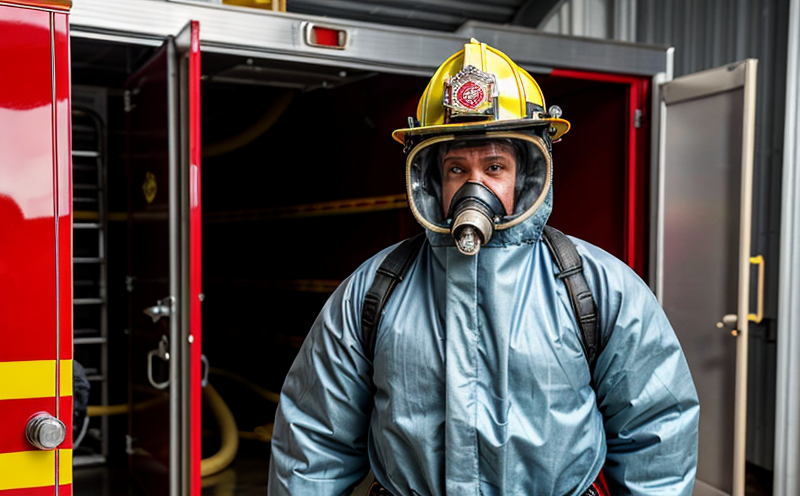Firefighter Jacket and Trousers Shrinkage Testing
The testing of firefighter protective clothing, particularly jackets and trousers, is a critical aspect of ensuring the safety and reliability of these essential items. Shrinkage in such gear can have significant implications on its performance during emergencies. This shrinkage test evaluates how much a fabric will contract after being washed and dried under specified conditions. Properly conducted, this testing helps manufacturers ensure that their products maintain their intended size and shape post-wash, thereby enhancing the firefighters' ability to fit into these protective garments correctly.
Shrinkage can be influenced by various factors including the type of fabric used, dyeing processes, and drying methods employed. In order to accurately assess shrinkage, it is important that both pre- and post-treatment samples are prepared in a controlled manner. Preparing specimens involves cutting out representative pieces from the jacket or trousers according to standard protocols specified in relevant international standards such as ISO 13948 for firefighter protective clothing.
The testing process itself typically follows these steps: firstly, the fabric sample is dried following washing procedures outlined by applicable standards. Secondly, after drying, the dimensions of each sample are measured using precision instruments. Lastly, the difference between initial and final measurements provides an accurate assessment of shrinkage percentage.
For jackets specifically designed for firefighters who work in extreme conditions, maintaining proper fit is crucial not only for comfort but also for functionality. A poorly fitting jacket could lead to discomfort during long hours on duty or even compromise protection if it does not cover all necessary areas adequately. Similarly, trousers must allow for easy mobility while still offering adequate coverage against hazards.
Standardized procedures ensure consistency across different manufacturers and batches of products. Compliance with recognized standards such as NFPA 1971 ensures that all protective clothing meets minimum performance requirements set forth by regulatory bodies like the National Fire Protection Association (NFPA).
Understanding the impact of shrinkage on firefighter protective equipment helps in selecting appropriate materials and processes during manufacturing stages. By conducting regular testing throughout production cycles, companies can identify potential issues early on and make adjustments if needed before large-scale production begins.
In conclusion, accurate shrinkage testing plays a vital role in maintaining high standards within the firefighting industry. It ensures that protective clothing remains functional and safe for use under demanding circumstances.
Industry Applications
- Fabric manufacturers: To ensure consistent quality of fabrics used in manufacturing firefighter protective clothing.
- Manufacturers of firefighting gear: To maintain proper fit and functionality throughout the product lifecycle.
- Quality assurance departments within fire service organizations: To verify compliance with relevant standards.
- R&D teams focused on improving materials or design for better performance under extreme conditions.
These applications highlight just a few ways in which shrinkage testing is integral to maintaining the integrity and effectiveness of firefighter protective clothing. By adhering strictly to these tests, stakeholders can ensure that they are delivering reliable products capable of protecting lives effectively.
Quality and Reliability Assurance
- Ensures consistency in product performance across batches.
- Prevents discrepancies between the expected and actual performance of fire protective clothing.
- Facilitates meeting regulatory requirements set by organizations like NFPA 1971.
- Aids in identifying any issues early during the manufacturing process so they can be addressed promptly.
By incorporating shrinkage testing into their quality assurance protocols, companies demonstrate their commitment to delivering high-quality products that meet or exceed industry standards. This not only enhances customer satisfaction but also builds trust within the community served by these professionals.
Environmental and Sustainability Contributions
The importance of reducing waste cannot be overstated, especially when dealing with materials intended for repeated use in high-stress environments like firefighting. By accurately assessing shrinkage through rigorous testing, manufacturers can optimize fabric usage which reduces material costs without compromising on safety or performance.
Additionally, understanding how different treatments affect the final product allows for more sustainable practices throughout production cycles. For example, selecting dyes and finishes that minimize water consumption during washing processes can help reduce overall environmental impact. Furthermore, knowing exactly how much shrinkage occurs ensures that excess fabric isn't used unnecessarily which contributes to reducing waste sent to landfills.
In summary, effective shrinkage testing supports both quality assurance efforts and sustainability goals by providing valuable insights into material behavior under real-world conditions. This information enables smarter decisions regarding resource allocation and process optimization ultimately leading to more environmentally friendly practices within the industry.





